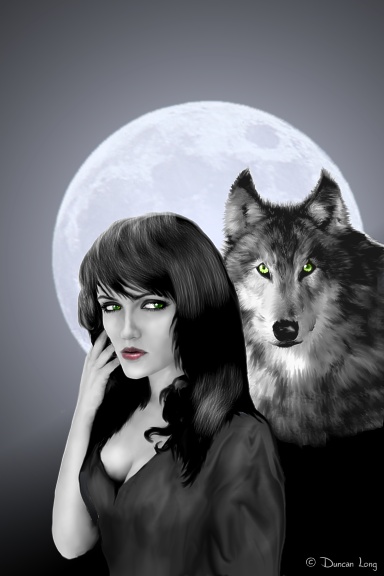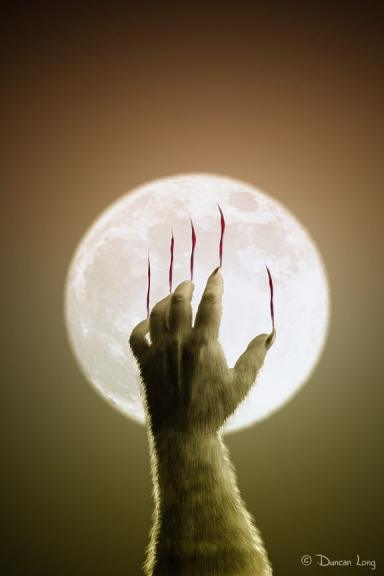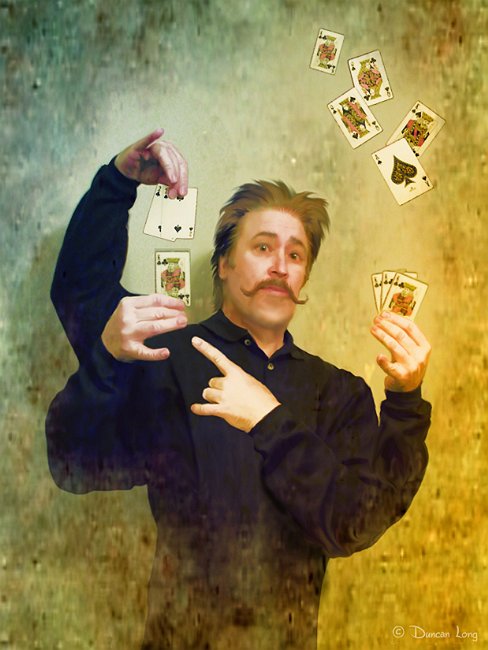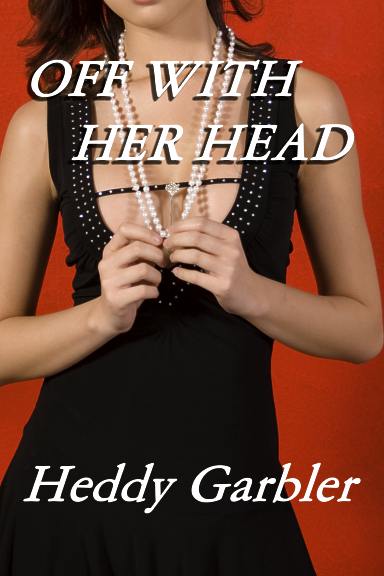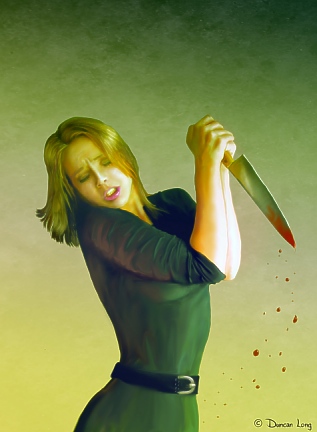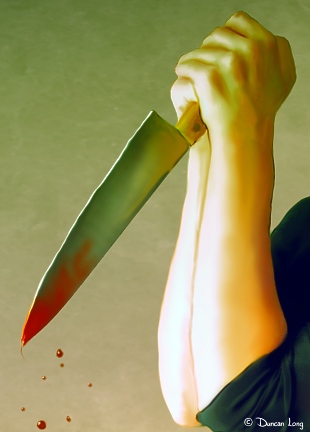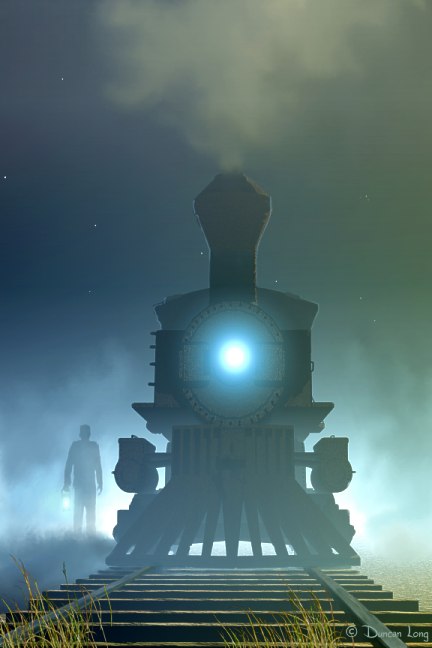With the downturn in the economy and a reduction of the number of titles many publishers are buying, many authors are now trying their hand at self-publishing. There’s never been a better time to do this; it’s a lot easier to self-publish these days than it was even a few years ago. And in addition to book packagers that cater to authors, print-on-demand services like Lulu.com and CreateSpace.com are geared up to produce small runs of books at competitive prices.
I’ve personally noted a huge increase in the numbers of authors that are contacting me to produce their book covers. Having a professional artist create a cover pretty much levels the playing field with self-published books. The covers are hard to distinguish from the big publishers’ offerings (in many cases because the artists are producing illustrations for both groups) and thus such an illustration puts the self-publisher into a good market position (the old saw that people judge a book by its cover applies to marketing).
That said, there are a few terms that a self-publisher may run into that can cause no little confusion. I have always suspected that the publishing jargon, like that of other trades, has developed in part to name processes, but also to confuse and discourage beginners, thereby keeping competition in check. (Maybe I’m just a cynic on this – but that’s my take.)
One caveat: I’m neither a lawyer nor do I operate a press. So all you’re about to read is subject to higher authority. And there are no higher authorities than a press operator or a lawyer. Just ask any artist who has crossed either of these folks.
Now, without further ado, I will betray my industry by revealing a few insider secrets with which the intrepid self-publisher may encounter:
Typeface: This is basically the family of letters, numbers, and punctuation that are used together in text or other lettering. Often you will hear typefaces called “fonts” – even by the pros in publishing. But technically the font is the size of the typeface letter while the typeface has to do with the actual design of the letters in all sizes of the family. The confusion comes about because most electronic typefaces can be scaled to various sizes – and Microsoft and other companies compounded the confusion by calling typefaces fonts. (That’s right, another reason to get on Microsoft’s case.)
There are a lot of categories of typefaces, and everyone has their own groupings it seems. But the basic divide among the more commonly used typefaces are the Serifs and Sans. The Sans (actually, Sans Serif – without Serif) don’t have the various curves and ornaments of the Serifs. Good examples of Sans typefaces are Helvetica and Ariel. Common Serifs are New Times Roman and Georgia. You’ll also find ornamental, script, and other fonts; my advice is to use these latter categories sparingly as you can quickly achieve an amateur look without even half trying to.
Also, try to confine the different typefaces employed in your entire publication to two – or better yet, just one (along with its italic form). One elegant typeface that doesn’t call attention to itself puts you well on the road to a professional look.
Never underline the typeface in a book that’s going to be published (use italics instead) and try to avoid using bold lettering as well (use a larger font if you need a bolder look).
Many claim that Serifs are easier to read in print; this may or may not be true these days since we are bombarded with all sorts of typefaces. However it’s a good rule to use Serifs in print text. Sans can give a more modern look, however, and might be suitable for a science fiction novel or the like – although even there I would suggest trying a serif first.
Some typefaces have been designed for easier reading on computer screens. If you’re strictly marketing your title as an ebook, then using one of these is a good idea. Also, be sure you have all the licensing to use a typeface in your book (you can find the typeface foundry in the information within the typeface itself. This may also reveal the licensing information. If not, going to the company’s site will generally lead you to the licensing information.
While in theory typefaces can’t be patented or copyrighted (at least here in the US), recent court rulings have blurred this idea by claiming that since software generates the typefaces, and the software can be patented, then the typefaces are subject to the patent (or copyright?) as well. Don’t ask me to explain that because I suspect the tortured logic at best and only works in court. But the court is where you may find yourself if you infringe on someones typeface, so be forewarned.
Kerning: This is the process of adjusting letter spacing to make the type look right to the eye. Kerning is more art than science. Most quality computer typefaces kern themselves to some extent. However with titles and such, kerning often needs to be done by hand. Key places to kern are between letters like A and V where instead of lining up side by side, the two overlap their spaces. One trick is to attempt to make the space on either side of a letter appear to be the same to your eye. This works if you have a trained eye. (I told you it is an art, didn’t I.)
RGB and CMYK: These are color palettes used in the printing industry. RGB (Red Green Blue) is basically the colors projected by a computer monitor. Mixing these light beams produces the millions of colors on the screen.
The catch with publishing comes with the fact that book cover colors are produced by light reflecting from the ink on paper. And the colors of inks are typically cyan, magenta, yellow, and black (CMYK – don’t ask about why the K stands for B – I warned you about confusing beginners, right?). Just to keep things crazier, some presses use an additional color or two to get more precise colors.
The thing to remember is that when going from the RGB of the screen to the CMYK of printing, some of the brightness and spectrum width is lost. That means pictures on your monitor look more intense and vibrant than they will in print. Fortunately most of us adjust to this without thinking about it.
One danger (especially for PC users) is that it’s possible to crank up the brightness to see a much wider range of color than will ever be possible to create in print. This can lead to covers that are much darker than hoped for, often with the colors so dark as to be hopelessly awful. This isn’t as much of a problem as it once was; modern color cards and monitors are coming much closer to what the appearance is in print. But don’t crank up the brightness of your monitor if you want to see what the print version of a picture will look like.
Presses will generally prefer one format over the other, so find out which is better. Also, while software is good at transforming RPG palettes into the CMYK format, it’s generally terrible at going from CMYK to RPG. So don’t try to change a CMYK picture into an RPG or you will likely have a disaster on your hands.
Finally, be sure your press does a test printing for you to see before cranking out thousands of copies of your title. It saves a lot of tears and even lawsuits.
DPI: Dots Per Inch. Basically pictures on the Internet look fine at 72 or 96 dots while print needs more detail and requires 300 or 350 dots per inch. Many beginning self-publishers think that a picture taken from the Net will make a swell cover – and discover the results are blurry and grainy (and also probably illegal if the proper licensing isn’t purchased). Presses will often use a different system – just don’t worry about it and go with the DPI of your computer.
Licensing: The copyright law allows an artist or photographer to sell the right to use their pictures in a variety of ways. You need to be sure you’ve purchased the rights to any picture that you use on or in a book. “I just found it” is not a legal defense, and failure to secure rights doesn’t mean you forfeit the money you make on the book, but rather the harm done to potential sales.
And that harm is measured in the maximum potential sales. We’re talking loss of home and perhaps your firstborn daughter if things go really poorly in court. So unless you have a fortune sitting in a bank account that you’re wanting to shell out to some grubby artist like me, be sure you purchase the rights to a picture.
Even if you purchase rights, it is easy to get tripped up. That’s because rights are very narrowly defined.
Purchasing the book cover rights means only that you can use the picture on that one book (and usually for advertising that book). If you want to make t-shirts with the picture, then you have to buy the right to do that. Ditto for book marks, stationery, web site display, mugs, mouse pads, posters, etc., etc.
Many self-publishers get this wrong – the book right you purchase only applies to that one book you buy it for, and only to its first edition. If you revise your book, or right another book in the series, you’ll need to buy rights for that book as well.
Rights can be exclusive, meaning that the picture won’t appear on Joe Blow’s book as well as yours. Or the rights can be non-exclusive, meaning the picture might appear on some other author’s cover. And this can happen a lot these days with all the books going into print.
Generally the cut-rate stock picture sellers sell non-exclusive rights. That’s why the prices are so low. That’s also why self-publishers are regularly horrified to see the same picture (or parts of it) on books that are competing with them in the marketplace. My advice is to spend extra money and buy the exclusive book cover rights on any illustration you consider buying the rights to.
Galley: You probably won’t need to know this one unless you’re working with a big publisher (but it’s still good to know this). A galley is an early draft to the final layout of the book in the form it will have in the book; that is, it is typeset and all laid out. It no longer looks like the manuscript you sent to the publisher, and more like it will in the printed version.
After a manuscript has received its initial corrections, it soon graduates to its galley stage. Back when typesetting was done, the galley appeared pretty late in the game. Now that most manuscripts are sent to publishers in a digital format, the line between galley and edited manuscript has blurred quite a bit, and some publishers don’t even call any of the copies of the typeset manuscript a galley.
Once in the galley state, Xerox or computer printer copies of the galley are sent to line editors and the writer for corrections and changes. Generally the fewer changes the author makes to the galley, the better, though with modern computer typesetting this isn’t such a big deal. Back when lead typesetting was being done pretty much by hand, changes to a galley could end in a brawl between author and editor.
Before the book actually goes to print, galley copies may also be sent to reviewers as well as those who will write a positive endorsement for the cover or write ad copy for the book. Often the galley will be printed at the actual size of the final book with registration, cropping, and other marks the press will use to center the page along its margins.
BLAD: The BLAD (Basic Layout and Design) is something self-publishers could use to good effect – but most don’t because they haven’t heard of it. A BLAD is an abbreviated version of a book and generally includes only the cover art, the copyright page, and typically the first chapter, perhaps followed by an order form and contact information and maybe a blurb about the author.
Publishers often release a BLAD to potential buyers, reviewers, etc., thereby launching a media campaign. The BLAD is a great way to show off the syle and level of writing in a book and generate interest in it.
Recently publishers have started uploading BLADs to file-sharing services. This creates a lot of free publicity. It also gives potential readers a sample chapter to entice them into buying the whole book.
My advice is that if you’re self-publishing, you should make a BLAD of any book you produce and upload it to some of the file-sharing services. It has the added plus of discourages pirating of your whole book, and can bring in a lot of extra sales with virtually zero investment on your part.
The best format for an electronic BLAD is the PDF (more on this in a moment). With an electronic BLAD, be sure to hot-link to the site you’re selling your book from. Adding an order form at the back of the book is a great idea, too.
PDF: The Portable Document Format was created by Adobe Systems in 1993 for document exchange. It has become the standard for ebooks and also the preferred form for documents submitted to most presses. Modern PDF files have the colors and layout locked in place so there are no surprises when the book comes back from the printer – which is why the PDF has more or less become the standard in publishing.
The PDF is also ideal for ebooks, which means that when you produce a PDF for your publisher, you have an ebook ready to sell as well (with the caveat that ebooks are easy to pirate).
If you make your own PDFs (there is freeware and inexpensive software for this purpose), be sure to use the “PDF/X-1a” publisher profile if it is available (and your press can handle it), and be sure to “flatten” all the layers when creating your PDF as well as packaging all the typefaces and pictures in it (remember that your pictures need to be at 300 DPI). Doing all this can help prevent any unexpected errors in your layout.
Bleed: Bleed is the extra space around a cover, generally a quarter inch on all sides. The purpose of the bleed is to prevent any white borders from showing when the press trims the cover. Since trimming is a mechanical process, there’s a little slop in things. Having the cover bleed past the trim area means that the printer has a little extra margain for error.
The addition of the bleed to a cover means that a cover that is 5.5 x 8.5 inches will become a “wrap” that’s 9 inches high (8.5 plus 0.25 bleed on the top and 0.25 bleed on the bottom) and 11.5 inches wide (5.5 inches front plus 5.5 back plus 0.25 bleed on the left plus 0.25 bleed on the right) – plus the width of the spine. There’s a lot of room for error, so always double or even triple check your measurements.
TIF and JPG: If you’re only submitting a cover illustration to a publisher who will do the lettering and so forth for your book cover, then chances are the press will want the illustration as a TIF (Tag Image File Format – pronounced just like it appears) or JPG (Joint Pictures Expert Group – pronounced jay-peg and sometimes abbreviated as JPEG).
JPGs can be quite a bit smaller than TIFs, but you need to be sure that the picture is only slightly compressed. Otherwise the illustration can get lots of artifacts (little grainy splotches) that look like flaws in the printing process. For this reason a lot of presses insist you send a TIF since it is harder to screw up.
I have only scratched the surface here. But knowing these terms will generally help you navigate through most of the straits you’ll encounter when self-publishing.
